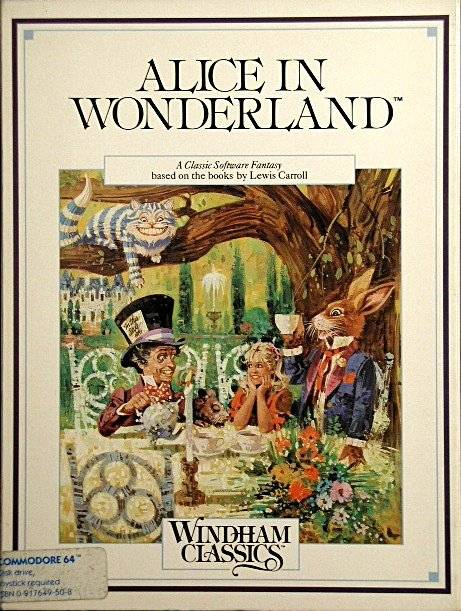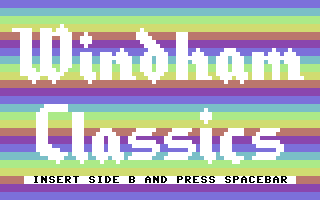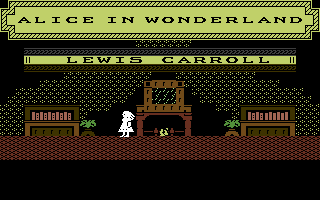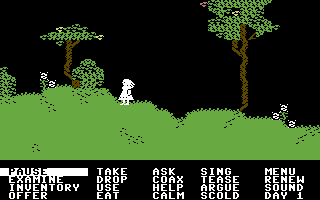Part 1: In which introductions are made.


In 1982,
Commodore International released the
Commodore 64, a computer with unprecedented sound and graphics quality for its paltry $600 price point. At the time, I was still using a
TRS-80, and while it certainly scratched my computing itch, I dreamed of the day when I would have access to such luxuries as full (16-)color, dedicated sound hardware (as opposed to hijacking the tape drive mechanism in assembly code), and a massive 64K of built-in RAM. The day finally came two years later, when my mother essentially bribed me with one to get me to do my homework. While I nearly bought a
Coleco ADAM at the last minute (and I'm very glad I didn't!), I decided to stick with the purchase I'd already researched, and it led to many months of happy computing.


Naturally, when I wasn't coding toy programs in BASIC or typing school papers with my fancy dot-matrix printer, I was playing games. The Commodore 64 had many excellent games, and a number of the big game companies of today got their starts in that era. One company that failed to survive was the Telarium Corporation, which largely produced graphic-enhanced text adventures based on science fiction or fantasy novels; their label 'Windham Classics' was reserved for games based on public-domain works, like 'Swiss Family Robinson' and 'The Wizard of Oz'. Two of these games were a bit different from the rest, though, using a largely graphical interface instead of the text parsers of their brethren. One was 'Below the Root'; the other was 'Alice in Wonderland'.


Alice in Wonderland was a game I enjoyed the heck out of back in the day (yo). In the introductory movie you can see a bit of the basic gameplay: walk Alice around the screen in a Zelda 2-ish fashion (though predating that game), seeking a way to first enter Wonderland, then get back out again. The game is largely controlled by the joystick, though you have to use the keyboard for a few puzzles (which I will explain at the time).

The controls are simple. Push left or right on the stick to walk in that direction...

...pressing the fire button and to the side causes Alice to jump...

...and if you hold the stick sideways after a jump, Alice will begin to run when she lands.

Unless she falls too far, in which case...

...she hits the ground rather painfully. She looks like she's snapped her neck when she hits, but you can't actually be hurt by falling too far.

She does the same thing if she walks into a wall. I find this inexplicably amusing.


Press down to crouch, and sideways to crawl once crouched; press up to stand...

...or to climb up ladders, ropes, or chains. Down lets you climb down things.

Alice can also swim, using the same controls as walking, and enter doors if you press the button in front of them.

There are a few other controls, but they won't be enabled until we pick up certain items. Finally, holding down the fire button and pushing down on the stick...


...opens the menu. You can see it below this slice of delightful English countryside, which is, coincidentally enough, where our adventure begins. Most of the options are self-explanatory, but I'll cover them all briefly. 'Pause' is somewhat misleadingly labeled; the game automatically pauses when the menu's brought up, and you can choose 'Pause' to leave the menu without actually doing anything. 'Examine' is for looking at things on the ground, as well as larger objects that can't be picked up, like signs. 'Inventory' just lets you look at what you're carrying; the next several options ('Offer', 'Take', 'Drop', 'Use', and 'Eat') give you several ways to make use of that inventory. 'Ask' leads to a submenu of three questions: 'Who are you?', 'Where am I?', and 'Why are you doing that?' These questions, along with the options 'Coax', 'Help', 'Calm', 'Sing', 'Tease', 'Argue', and 'Scold', are how you talk with the curious people you'll meet; naturally, different approaches get different results, and the wrong approach (or the right one) can cause someone to leave. ('Sing', incidentally, leads to its own submenu, an inventory of songs you learn through the adventure.) 'Menu' leads to the main menu, where you start, continue, save, and load games, or watch a brief demo of game play. 'Renew' will send you to a safe location at the cost of a game day; it's not terribly useful, especially since it doesn't avoid most of the ways you can actually get stuck in this game (generally, using up or losing a key item too soon), but it's there if you need it. 'Sound' toggles sound off; you don't miss much, except for the songs. Finally, 'Day 1' tells us we're on the first day of our quest; we're on a timer, but it's not very strict, and we shouldn't have any trouble getting the best ending.

Whew, that's rather a lot of talking from me, isn't it? I think it's time to introduce the true star of this Let's Play: Alice herself. Say hello, Alice!

Hello, everyone! The fellow with the curious mouthless face is going to be keeping me out of trouble during this game, but it'll be up to you to help me do more than sit about and enjoy the lovely summer weather. (She said, looking up at the curiously black sky.) We'll start with a simple choice. Should I go on as I've begun, and head up the hill to the left, or be a bit contrary, turn around, and go down the hill to the right? I'm waiting for your requests!

 In 1982, Commodore International released the Commodore 64, a computer with unprecedented sound and graphics quality for its paltry $600 price point. At the time, I was still using a TRS-80, and while it certainly scratched my computing itch, I dreamed of the day when I would have access to such luxuries as full (16-)color, dedicated sound hardware (as opposed to hijacking the tape drive mechanism in assembly code), and a massive 64K of built-in RAM. The day finally came two years later, when my mother essentially bribed me with one to get me to do my homework. While I nearly bought a Coleco ADAM at the last minute (and I'm very glad I didn't!), I decided to stick with the purchase I'd already researched, and it led to many months of happy computing.
In 1982, Commodore International released the Commodore 64, a computer with unprecedented sound and graphics quality for its paltry $600 price point. At the time, I was still using a TRS-80, and while it certainly scratched my computing itch, I dreamed of the day when I would have access to such luxuries as full (16-)color, dedicated sound hardware (as opposed to hijacking the tape drive mechanism in assembly code), and a massive 64K of built-in RAM. The day finally came two years later, when my mother essentially bribed me with one to get me to do my homework. While I nearly bought a Coleco ADAM at the last minute (and I'm very glad I didn't!), I decided to stick with the purchase I'd already researched, and it led to many months of happy computing.
 Naturally, when I wasn't coding toy programs in BASIC or typing school papers with my fancy dot-matrix printer, I was playing games. The Commodore 64 had many excellent games, and a number of the big game companies of today got their starts in that era. One company that failed to survive was the Telarium Corporation, which largely produced graphic-enhanced text adventures based on science fiction or fantasy novels; their label 'Windham Classics' was reserved for games based on public-domain works, like 'Swiss Family Robinson' and 'The Wizard of Oz'. Two of these games were a bit different from the rest, though, using a largely graphical interface instead of the text parsers of their brethren. One was 'Below the Root'; the other was 'Alice in Wonderland'.
Naturally, when I wasn't coding toy programs in BASIC or typing school papers with my fancy dot-matrix printer, I was playing games. The Commodore 64 had many excellent games, and a number of the big game companies of today got their starts in that era. One company that failed to survive was the Telarium Corporation, which largely produced graphic-enhanced text adventures based on science fiction or fantasy novels; their label 'Windham Classics' was reserved for games based on public-domain works, like 'Swiss Family Robinson' and 'The Wizard of Oz'. Two of these games were a bit different from the rest, though, using a largely graphical interface instead of the text parsers of their brethren. One was 'Below the Root'; the other was 'Alice in Wonderland'.
 Alice in Wonderland was a game I enjoyed the heck out of back in the day (yo). In the introductory movie you can see a bit of the basic gameplay: walk Alice around the screen in a Zelda 2-ish fashion (though predating that game), seeking a way to first enter Wonderland, then get back out again. The game is largely controlled by the joystick, though you have to use the keyboard for a few puzzles (which I will explain at the time).
Alice in Wonderland was a game I enjoyed the heck out of back in the day (yo). In the introductory movie you can see a bit of the basic gameplay: walk Alice around the screen in a Zelda 2-ish fashion (though predating that game), seeking a way to first enter Wonderland, then get back out again. The game is largely controlled by the joystick, though you have to use the keyboard for a few puzzles (which I will explain at the time). The controls are simple. Push left or right on the stick to walk in that direction...
The controls are simple. Push left or right on the stick to walk in that direction... ...pressing the fire button and to the side causes Alice to jump...
...pressing the fire button and to the side causes Alice to jump... ...and if you hold the stick sideways after a jump, Alice will begin to run when she lands.
...and if you hold the stick sideways after a jump, Alice will begin to run when she lands. Unless she falls too far, in which case...
Unless she falls too far, in which case... ...she hits the ground rather painfully. She looks like she's snapped her neck when she hits, but you can't actually be hurt by falling too far.
...she hits the ground rather painfully. She looks like she's snapped her neck when she hits, but you can't actually be hurt by falling too far. She does the same thing if she walks into a wall. I find this inexplicably amusing.
She does the same thing if she walks into a wall. I find this inexplicably amusing. 
 Press down to crouch, and sideways to crawl once crouched; press up to stand...
Press down to crouch, and sideways to crawl once crouched; press up to stand... ...or to climb up ladders, ropes, or chains. Down lets you climb down things.
...or to climb up ladders, ropes, or chains. Down lets you climb down things. Alice can also swim, using the same controls as walking, and enter doors if you press the button in front of them.
Alice can also swim, using the same controls as walking, and enter doors if you press the button in front of them. There are a few other controls, but they won't be enabled until we pick up certain items. Finally, holding down the fire button and pushing down on the stick...
There are a few other controls, but they won't be enabled until we pick up certain items. Finally, holding down the fire button and pushing down on the stick...
 ...opens the menu. You can see it below this slice of delightful English countryside, which is, coincidentally enough, where our adventure begins. Most of the options are self-explanatory, but I'll cover them all briefly. 'Pause' is somewhat misleadingly labeled; the game automatically pauses when the menu's brought up, and you can choose 'Pause' to leave the menu without actually doing anything. 'Examine' is for looking at things on the ground, as well as larger objects that can't be picked up, like signs. 'Inventory' just lets you look at what you're carrying; the next several options ('Offer', 'Take', 'Drop', 'Use', and 'Eat') give you several ways to make use of that inventory. 'Ask' leads to a submenu of three questions: 'Who are you?', 'Where am I?', and 'Why are you doing that?' These questions, along with the options 'Coax', 'Help', 'Calm', 'Sing', 'Tease', 'Argue', and 'Scold', are how you talk with the curious people you'll meet; naturally, different approaches get different results, and the wrong approach (or the right one) can cause someone to leave. ('Sing', incidentally, leads to its own submenu, an inventory of songs you learn through the adventure.) 'Menu' leads to the main menu, where you start, continue, save, and load games, or watch a brief demo of game play. 'Renew' will send you to a safe location at the cost of a game day; it's not terribly useful, especially since it doesn't avoid most of the ways you can actually get stuck in this game (generally, using up or losing a key item too soon), but it's there if you need it. 'Sound' toggles sound off; you don't miss much, except for the songs. Finally, 'Day 1' tells us we're on the first day of our quest; we're on a timer, but it's not very strict, and we shouldn't have any trouble getting the best ending.
...opens the menu. You can see it below this slice of delightful English countryside, which is, coincidentally enough, where our adventure begins. Most of the options are self-explanatory, but I'll cover them all briefly. 'Pause' is somewhat misleadingly labeled; the game automatically pauses when the menu's brought up, and you can choose 'Pause' to leave the menu without actually doing anything. 'Examine' is for looking at things on the ground, as well as larger objects that can't be picked up, like signs. 'Inventory' just lets you look at what you're carrying; the next several options ('Offer', 'Take', 'Drop', 'Use', and 'Eat') give you several ways to make use of that inventory. 'Ask' leads to a submenu of three questions: 'Who are you?', 'Where am I?', and 'Why are you doing that?' These questions, along with the options 'Coax', 'Help', 'Calm', 'Sing', 'Tease', 'Argue', and 'Scold', are how you talk with the curious people you'll meet; naturally, different approaches get different results, and the wrong approach (or the right one) can cause someone to leave. ('Sing', incidentally, leads to its own submenu, an inventory of songs you learn through the adventure.) 'Menu' leads to the main menu, where you start, continue, save, and load games, or watch a brief demo of game play. 'Renew' will send you to a safe location at the cost of a game day; it's not terribly useful, especially since it doesn't avoid most of the ways you can actually get stuck in this game (generally, using up or losing a key item too soon), but it's there if you need it. 'Sound' toggles sound off; you don't miss much, except for the songs. Finally, 'Day 1' tells us we're on the first day of our quest; we're on a timer, but it's not very strict, and we shouldn't have any trouble getting the best ending. Whew, that's rather a lot of talking from me, isn't it? I think it's time to introduce the true star of this Let's Play: Alice herself. Say hello, Alice!
Whew, that's rather a lot of talking from me, isn't it? I think it's time to introduce the true star of this Let's Play: Alice herself. Say hello, Alice! Hello, everyone! The fellow with the curious mouthless face is going to be keeping me out of trouble during this game, but it'll be up to you to help me do more than sit about and enjoy the lovely summer weather. (She said, looking up at the curiously black sky.) We'll start with a simple choice. Should I go on as I've begun, and head up the hill to the left, or be a bit contrary, turn around, and go down the hill to the right? I'm waiting for your requests!
Hello, everyone! The fellow with the curious mouthless face is going to be keeping me out of trouble during this game, but it'll be up to you to help me do more than sit about and enjoy the lovely summer weather. (She said, looking up at the curiously black sky.) We'll start with a simple choice. Should I go on as I've begun, and head up the hill to the left, or be a bit contrary, turn around, and go down the hill to the right? I'm waiting for your requests!